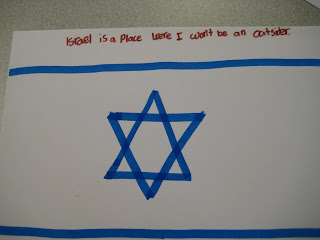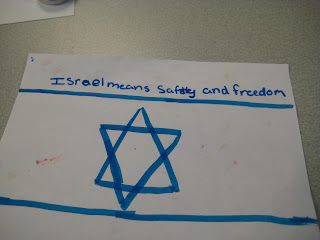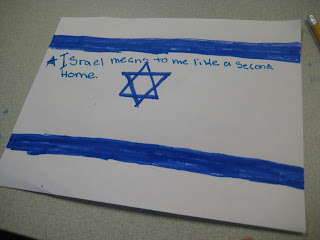I used our past two weekday sessions to summarize and synthesize information I've shared with my students over the past year.
First, I asked them to share information they could recall about each of the four edot we studied this year - American Jews, Ashkenazi (Western and Eastern European) Jews, Indian Jews and Moroccan Jews. I put all the responses we could fit on the whiteboard into four columns - one column for each of the edot. Then we looked across the columns to find identical pieces of information and I circled these.
Then I asked the students to look at the circled responses:
They worshiped one God.
They read the Torah and followed its commandments.
They were looking for a safe place to live where they could be free to be Jews.
They spoke the language of where they lived.
They borrowed recipes from people they lived with and made them kosher.
They originally came from Israel.
They prayed in Hebrew.
They taught their children Hebrew and Jewish prayers.
They were trying to find a place to earn money and to do what they wanted to do to earn the money.
They dressed like the people around them.
They wore tallits (prayer shawls) and kippas when they prayed.
They prayed in synagogues.
They sang holiday songs with melodies they heard around them.
Using the responses above, we had a discussion about "the Jewish experience" in the world between the Roman exile some 2,000 years ago, and the establishment of the modern State of Israel in 1948. In summary, the discussion revealed that we were a "wandering" nation, always looking for a safe place to be free to be Jewish in the open and to have careers we chose for ourselves. In one case, we found a place that fit what we were looking for (the United States), but in most cases, we might feel free for a while, but then things changed and we had to leave our homes to find another place to live where we could feel safe again.
At this point, we took a brief pause from our discussion, and without any explanation, I began to issue commands in Hebrew (using vocabulary we had learned in previous sessions) as follows:
La'koom, la'lechet la'shoolchan ha'katan v'lakachat neeyar lavan mey'ha'shoolchan ha'katan. (Get up, walk to the small table and take white paper from the small table.)
Achshav, leekpotz la'keeseh, v'lashevet al ha'keeseh. (Now, jump to the chair, and sit on the chair.)
Continuing on with the commands, I asked the students to watch and listen to me, as I put a white piece of paper on the board, and took a blue marker, then drew a line across the top of the paper with the marker. I issued commands to myself, until I had drawn the Israeli flag on my piece of paper. The students then did the same as they followed my commands. Once we had all made the flag, I continued the discussion activity.
I erased everything we had written on the board about the edot, and wrote ISRAEL on the top, then asked the students to share what they thought of when they saw the word.
 |
| On Wednesday, the Shira track students joined us for our discussion. You can see the list growing on the board, as I wrote down all their responses. The words "safety" and "freedom" are on the list, as are candy (one of the students remembered a delicious chewy candy he was given in Israel), parties, Torah, Western Wall and Red Sea among others. |
With just a few minutes left to our session, I asked the students to recall our earlier discussion about the four edot we had studied this year and how they were searching for a place to feel safe and free to be Jewish in the open, then asked them to write one sentence in the white space on their flag that shared "What Israel Means to Me." Below are some examples of what they wrote:
On a lighter note, this week the sixth graders visited Ian in the Youth Lounge again, this time to see how a typical weekday session in 7th grade would begin, and then to do a team-building activity. Here's how it typically begins with a very relaxed atmosphere, and a time to play games and schmooze with each other:
After about 10 minutes, Ian called everyone together to sit on the sofas, so that he could review what he shared last week about what they could expect to learn about and do in 7th grade. Then he led us all into the hallway outside the Youth Lounge for a team-building activity. All the students were asked to stand on a very narrow board. Working together, they had to figure out a way to get each of them off one end of the board, one by one, without any of them falling off the board. It took a few minutes, but they figured it out!
Let me take this opportunity to wish all you mothers a very happy Mother's Day this coming Sunday. Remember that we have no JQuest classes on Sunday to allow you that much more time to spend together with your families. ENJOY!





















































